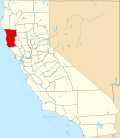References
- 1 2 U.S. Geological Survey Geographic Names Information System: Shiegho, California
- ↑ Powers, Stephen (1877), "Chapter XVIII: The Yo-Kai'-A", Tribes of California, Contributions to North American Ethnology, vol. 3, US Department of the Interior, pp. 163–173, doi:10.1525/9780520342354-022 ; see in particular p. 172
